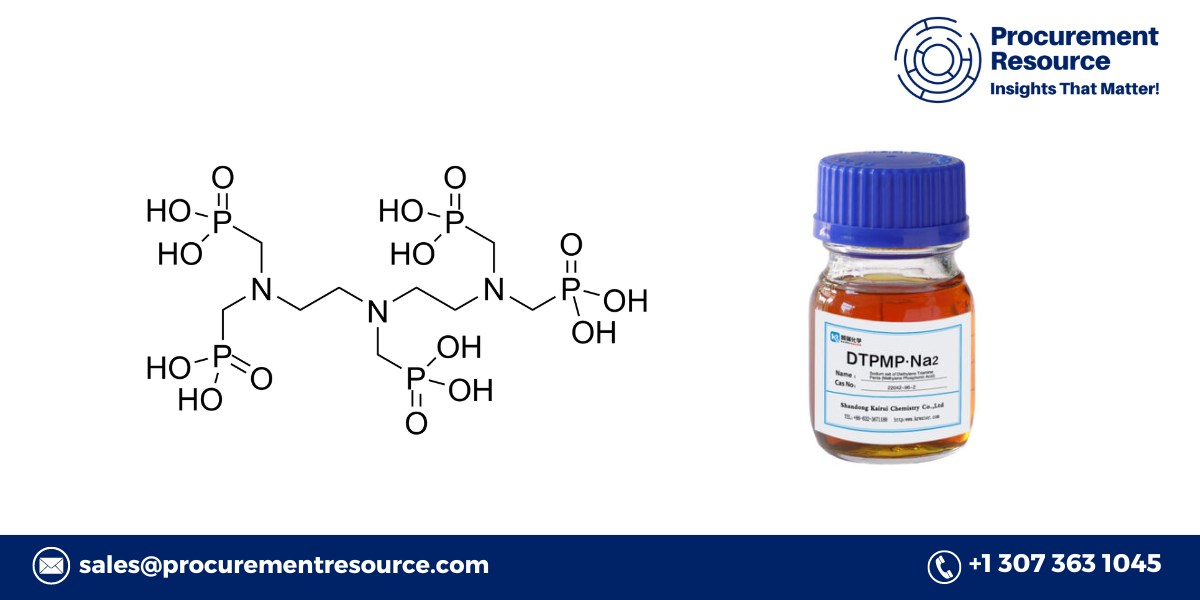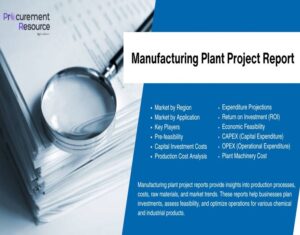
DTPMP Production Cost
Diethylenetriaminepenta(methylene phosphonic acid) (DTPMP) is a versatile chemical compound extensively used in various industries. Known for its strong chelation properties and ability to inhibit scale formation, DTPMP plays a crucial role in water treatment, scale inhibition, and as a chelating agent. This compound is particularly effective in preventing calcium carbonate and other scale deposits in water systems, making it essential in sectors such as oil and gas, water treatment, and cleaning products. Understanding the DTPMP production cost is vital for manufacturers, suppliers, and end-users, as it influences pricing, market competitiveness, and profitability. Several factors contribute to the production cost, including raw material expenses, energy consumption, production methods, and compliance with environmental regulations. This article explores the components affecting DTPMP production costs and examines their broader industry implications.
Key Factors Affecting DTPMP Production Costs
- Raw Material Expenses:
- Phosphorus Compounds: The primary raw materials in DTPMP production include phosphorus compounds, especially phosphorous acid and phosphonates. The cost of these materials is driven by global supply and demand, along with fluctuations in related commodities like phosphate rock and elemental phosphorus.
- Diethylenetriamine (DETA): Another critical raw material is diethylenetriamine (DETA), a chemical derived from ethyleneamines. The price and availability of DETA are influenced by crude oil prices, as ethyleneamines are often produced from petrochemical feedstocks.
- Water and Solvents: Water and other solvents are also required in significant quantities. Although their costs are generally lower than primary raw materials, they still impact overall production costs, especially in regions facing water scarcity.
- Energy Consumption:
- Electricity and Heat: Producing DTPMP is energy-intensive, requiring substantial amounts of electricity and heat. Energy costs vary widely depending on the region, energy source, and production facility efficiency. For example, areas with access to cheaper and stable electricity sources may have a cost advantage.
- Fossil Fuels: Some production processes utilize fossil fuels like natural gas or coal to generate the necessary heat. The cost of these fuels, which fluctuates with global market conditions, directly influences the overall production cost of DTPMP.
- Production Methods:
- Batch vs. Continuous Production: DTPMP can be produced using either batch or continuous methods. Batch production involves producing set quantities in individual batches, which offers flexibility but may result in higher costs due to inefficiencies and downtime. Continuous production, which operates on an ongoing basis, tends to be more cost-effective but requires higher initial capital investment.
- Process Optimization: Efficient production processes significantly influence overall costs. Optimizing processes through advanced catalysts, improved reactor designs, and better heat management can reduce energy consumption, minimize waste, and lower production costs.
- Labor and Overhead Costs:
- Skilled Workforce: Producing DTPMP requires skilled labor in areas like chemical engineering, process control, and quality assurance. Labor costs vary by region, availability of skilled workers, and local labor laws.
- Maintenance and Repairs: Regular maintenance and repairs are essential to ensure smooth production and prevent costly breakdowns. These costs, along with equipment depreciation, contribute to the overall production cost.
- Overhead Expenses: Overhead costs, including administrative expenses, facility rent, insurance, and compliance with safety and environmental regulations, also add to the total production cost.
- Environmental Compliance:
- Waste Management: DTPMP production generates waste materials that must be managed in compliance with environmental regulations. The cost of waste treatment, disposal, and adherence to environmental standards can impact overall production costs.
- Emission Control: Emission control measures, such as scrubbers and filters, are often required to reduce environmental impact. These measures add to the capital and operational costs of production facilities.
- Sustainability Initiatives: With increasing pressure to adopt sustainable practices, DTPMP production may involve additional costs related to reducing environmental footprints, such as investing in renewable energy, improving energy efficiency, and lowering greenhouse gas emissions.
- Research and Development (R&D):
- Process Innovation: Ongoing R&D efforts aimed at improving production processes can lead to long-term cost reductions. Innovations in catalyst design, reaction conditions, and process control can enhance efficiency, reduce waste, and lower energy consumption.
- Product Quality and Purity: R&D also focuses on improving DTPMP quality and purity, which can boost performance in various applications. Achieving higher product quality may require additional investments in technology and quality control but can command premium pricing in the market.
- Global Market Dynamics:
- Supply Chain Logistics: The cost of transporting raw materials and distributing finished DTPMP to customers varies depending on the location and efficiency of the supply chain. Factors such as transportation costs, import/export tariffs, and geopolitical stability influence the overall cost structure.
- Competition and Market Demand: The level of competition in the DTPMP market, along with demand fluctuations, can impact production costs. In competitive markets, producers may need to invest in cost-saving measures to maintain profitability, while strong demand may give producers more pricing power.
- Capital Investment:
- Facility Construction: Significant capital investment is required to construct a DTPMP production facility, including land acquisition, building construction, equipment procurement, and installation. Amortizing these capital costs over the facility’s life contributes to the overall production cost.
- Technology Upgrades: As production technologies advance, existing facilities may need upgrades to remain competitive and comply with regulations. The cost of these upgrades, along with regular maintenance and modernization, is an important factor in DTPMP production costs.
Case Study: A Hypothetical DTPMP Production Facility
To illustrate the various factors influencing DTPMP production costs, consider a hypothetical facility located in a region with moderate energy costs, raw material access, and a skilled workforce. This facility operates a continuous production process and invests in process optimization and environmental compliance.- Raw Material Costs: The facility sources phosphorus compounds and DETA from nearby suppliers, benefiting from lower transportation costs. However, fluctuations in raw material prices still impact overall production costs.
- Energy Consumption: The facility uses electricity and natural gas to power production processes. The region’s moderate energy costs help maintain a stable cost structure, though changes in energy prices could affect costs.
- Production Efficiency: The continuous production process, combined with optimization measures, allows the facility to operate efficiently, reducing downtime and minimizing waste, which lowers production costs.
- Labor and Overhead: The facility employs skilled workers and invests in regular maintenance to ensure smooth operation. Overhead costs, including environmental compliance, contribute to total production costs.
- Environmental Compliance: The facility has implemented emission control and waste management practices to comply with regulations, which add to operational costs.
- R&D and Innovation: The facility allocates resources to R&D aimed at improving efficiency and product quality, expecting long-term cost savings and enhanced competitiveness.
- Capital Investment: Initial capital investment in the facility is amortized over several years, contributing to production costs. The facility also invests in periodic technology upgrades to remain competitive.
Future Outlook for DTPMP Production Costs
- Technological Advancements:
- New production technologies and optimization techniques may reduce DTPMP production costs over time. Innovations in catalyst design, reaction conditions, and energy efficiency can lower raw material and energy consumption, waste generation, and overall production costs.
- The adoption of digital technologies, such as advanced process control systems and data analytics, can further enhance production efficiency and reduce costs by enabling real-time monitoring and optimization.
- Environmental and Regulatory Pressures:
- Stricter environmental regulations may increase DTPMP production costs in the future, requiring additional investments in technology and infrastructure to meet compliance standards.
- Conversely, regulatory incentives for sustainable practices, such as carbon credits or renewable energy subsidies, could offset some costs and support competitive pricing.
- Global Market Trends:
- The global DTPMP market is expected to grow, driven by rising demand from industries like water treatment, oil and gas, and cleaning products. This growth may create economies of scale, reducing production costs as facilities expand capacity.
- However, fluctuations in raw material prices, energy costs, and supply chain logistics could introduce volatility into cost structures, requiring producers to remain agile in managing risks.
- Sustainability Initiatives:
- Increasing emphasis on sustainability and environmental stewardship is likely to influence DTPMP production’s future. Producers investing in greener production methods, such as renewable energy sources or efficient waste management, may achieve long-term cost savings and improve market positioning.
- The development of more sustainable alternatives to DTPMP could impact market demand and pricing dynamics, requiring producers to adapt their production strategies.
Conclusion
DTPMP production costs are shaped by various factors, including raw material expenses, energy consumption, production methods, labor and overhead costs, environmental compliance, and capital investment. Understanding these factors is crucial for manufacturers, suppliers, and end-users to navigate the competitive landscape and make informed decisions. As the global DTPMP market evolves, producers must invest in technological advancements, process optimization, and sustainability initiatives to maintain competitiveness and manage production costs effectively. By staying informed about market trends, regulatory developments, and technological innovations, stakeholders in the DTPMP industry can position themselves for long-term success in a dynamic and challenging environment.Contact Us:
Company Name: Procurement ResourceContact Person: Leo Frank
Toll-Free Number: USA & Canada — Phone no: +1 307 363 1045 | UK — Phone no: +44 7537 132103 | Asia-Pacific (APAC) — Phone no: +91 1203185500
Address: 30 North Gould Street, Sheridan, WY 82801, USA
Tags: DTPMP DTPMP Production Cost






